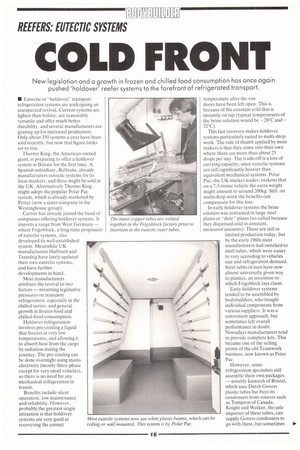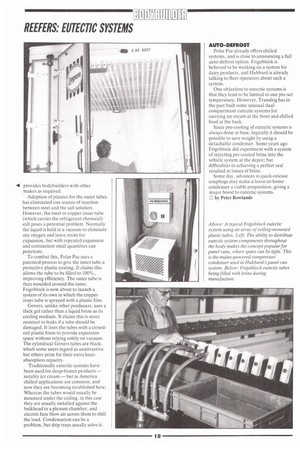COLD FRONT
Page 104

Page 106

If you've noticed an error in this article please click here to report it so we can fix it.
New legislation and a growth in frozen and chilled food consumption has once again pushed 'holdover' reefer systems to the forefront of refrigerated transport.
• Eutectic or "holdover" transport refrigeration systems are undergoing an unexpected revival. Current systems are lighter than before, are reasonably versatile and offer much better durability, and several manufacturers are gearing up for increased production. Only about 350 systems a year have been sold recently, but now that figure looks set to rise.
Thermo King, the American-owned giant, is preparing to offer a holdover system in Britain for the first time. A Spanish subsidiary, Reftrans, already manufacturers eutectic systems for its Local markets, and these might be sold in the UK. Alternatively Thermo King might adopt the popular Polar Pac system, which is already marketed by Petter (now a sister-company in the Westinghouse group).
Most manufacturers attribute the revival to two factors — mounting legislative pressures on transport refrigeration, especially in the chilled sector; and general growth in frozen-food and chilled-food consumption.
Holdover refrigeration involves pre-cooling a liquid that freezes at very low temperatures, and allowing it to absorb heat from the cargo by radiation during the journey. The pre-cooling can be done overnight using mains electricity (mostly three-phase except for very small vehicles), so there is no need for any mechanical refrigeration in transit.
Benefits include silent operation, low maintenance and reliability. However, probably the greatest single attraction is that holdover systems are very good at recovering the correct temperature after the van doors have been left open. This is because of the constant cold that is instantly on tap (typical temperatures of the brine solution would be -28°C and 32°C).
This fast recovery makes holdover systems particularly suited to multi-drop work. The rule of thumb applied by most makers is that they come into their own where there are more than about 25 drops per day. The trade-off is a loss of carrying capacity, since eutectic systems are still significantly heavier than equivalent mechanical systems. Polar Pac, the UK market leader, reckons that on a 7.5-tonne vehicle the extra weight might amount to around 200kg. Still, on multi-drop work the benefits can compensate for this loss.
In early holdover systems the brine solution was contained in large steel plates or -dole" plates (so-called because they dispensed cold in constant, measured amounts). These are still in limited production today, but by the early 1980s most manufacturers had switched to steel tubes, which were easier to vary according to vehicles size and refrigeration demand. Steel tubes in turn have now almost universally given way to plastics, an invention to which Frigoblock lays claim.
Early holdOver systems tended to be assembled by bodybuilders, who bought individual components from various suppliers. It was a convenient approach, but sometimes left overall performance in doubt. Nowadays manufacturers tend to provide complete kits. This became one of the selling points of the old Teamwork business, now known as Polar Pac.
However, some refrigeration specialists still assemble their own packages — notably Icemech of Bristol, which uses Dutch Govers plastic tubes but buys its condensers from sources such as Tempcon of Canada, Knight and Walker, the sole importer of these tubes, can supply Govers condensers to go with them, but sometimes provides bodybuilders with other makes as required.
Adoption of plastics for the outer tubes has eliminated one source of reaction between steel and the salt solution. However, the steel or copper inner tube (which carries the refrigerant chemical) still poses a potential problem. Normally the liquid is held in a vacuum to eliminate any oxygen and leave room for expansion, but with repeated expansion and contraction small quantities can penetrate.
To combat this, Polar Pac uses a patented process to give the inner tube a protective plastic coating. It claims this allows the tube to be filled to 100%, improving efficiency. The outer tube is then moulded around the inner. Frigoblock is now about to launch a system of its own in which the copper inner tube is sprayed with a plastic film.
Govers, unlike other producers, uses a thick gel rather than a liquid brine as its cooling medium. It claims this is more resistant to leaks if a tube should be damaged. It lines the tubes with a closedcell plastic foam to provide expansion space without relying solely on vacuum. The cylindrical Govers tubes are black, which some users regard as unattractive but others prize for their extra heatabsorption capacity.
Traditionally eutectic systems have been used for deep-frozen products — notably ice cream — but in America chilled applications are common, and now they are becoming established here. Whereas the tubes would usually be mounted under the ceiling, in this case they are usually installed against the bulkhead in a plenum chamber, and electric fans blow air across them to chill the load. Condensation can be a problem, but drip trays usually solve it. AUTO-DEFROST Polar Pac already offers chilled systems, and is close to announcing a full auto-defrost option. Frigoblock is believed to be working on a system for dairy products, and Hubbard is already talking to fleet operators about such a system.
One objection to eutectic systems is that they tend to be limited to one pre-set temperature. However, Transfrig has in the past built some unusual dualcompartment eutectic systems for carrying ice cream at the front and chilled food at the back.
Since pre-cooling of eutectic systems is always done at base, logically it should be possible to save weight by using a detachable condenser. Some years ago Frigoblock did experiment with a system of injecting pre-cooled brine into the vehicle system at the depot; but difficulties in achieving a perfect seal resulted in losses of brine.
Some day, advances in quick-release couplings may make a leave-at-home condenser a viable proposition, giving a major boost to eutectic systems.
0 by Peter Rowlands
















































































































